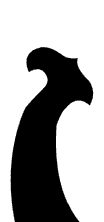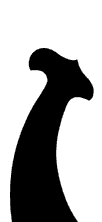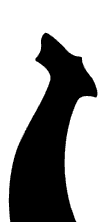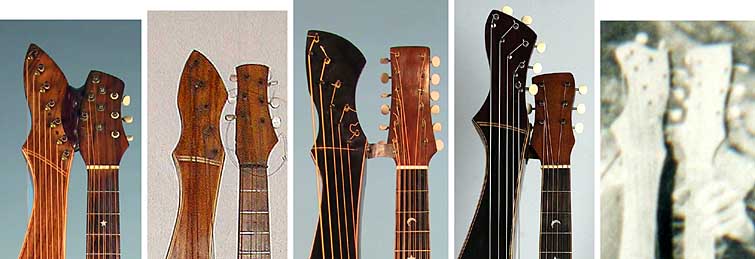| The
original One Armed Guitar, patented in 1896,
with short
bass arm and no extra strings. |
Knutsen received his second patent in 1898 for his harp guitar with
a long arm. This original design could hold 2, 3 or 5 bass strings, and
sometimes had none. 1897-1898 |
The Symphony style prototype allowed more room for proper tuners and
nut posts for the 5 bass strings. 1898-1899 |
Perhaps realizing that it looked too much like an elephant's trunk,
Knutsen experimented with his first personal "lefty"
(reversed for diagram). 1898-1899 |
Ultimately, he designed the very attractive new bass headstock. The arm
retains a slight bend from the previous design. 1898-1899 |
The arm is smoothed out for the final "mature" Symphony
model. 1899-1902
See
further details below
|
The "Evolving Symphony" headstocks begin with a gradual
change from the standard Symphony shape. 1902-1903
See
further details below
|
An extra flare is added at the end. 1903-1904 |
The new flare is lengthened, while the right pointed flare is now being reduced. 1904-1906 |
The new Seattle period Lower Bass Point harp guitar is introduced.
The first models have a very similar headstock, with further reduced
right flare.
(Type 1a) 1906-1908
|
The concave tip becomes convex and the headstock more vertical.
(Type 1b) 1907-1909 |
The
top of the headstock becomes smooth as the point in the middle is removed.
(Type 1c)
1910-1912 |
The extra point is re-introduced, the two bordering areas
scalloped.
(Type 2a)
1911-1913 |
An extra point on the left is added as the headstock becomes
more vertical and bulbous.
(Type 3a)
1912-1913 |
Four
points are retained while the top point gets a club shape.
(Type 3b) 1912-1913 |
The club is removed as the
upper left point moves to the top and the bass headstock becomes completely
vertical.
(Type 3c) 1913-1914 |
The
point at upper right is moved further upwards.
(type 3d) 1913-1914
See
further details below
|
Possibly the last type of bass headstock used, from a
specimen dated
(Type 3e) 1913-1914.
Still vertical, but the top left point is rounded while the other points
shift a bit. |



















